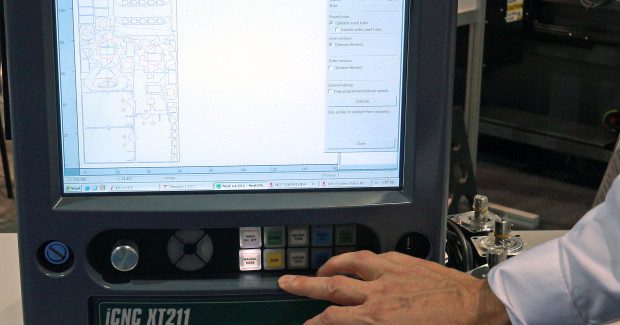Harnessing the Power of CNC Software for Plasma Cutting
What if you could get real time orchestration between the power source, the accessories connected to it and all of the other key elements of your cutting system?
Posted: January 10, 2015
Nearly all of today’s CNC-based plasma cutting systems are based on PC-technology. At a minimum, the User Interface (UI) runs under various Windows® operating systems. These platforms offer much more computing capabilities than necessary to manage just the UI and the graphics. Unfortunately, most of the CNC systems today do not utilize much of this computing power, mainly for historical reasons.
The history of CNC controls starts from NC controls (numeric control, taking care of tool motion and some simple I/O) that allowed the machine tool operator to key in numeric information describing a task for the machine. After that came punch tape readers and,a bit later, serial communication,which allowed the generation of those codes in the office environment. This advancement prevented machine tool down time when programming the tasks.
At this point, the industry started to refer to these systems as CNCs (computerized numeric controls). Programmers sent information to the CNC in the form of ESSI or EIA coding (Enhanced Synchronous Serial Interface and Electronic Industries Alliance, respectively). The coding described straight lines, arcs and some special commands, such as for kerf compensation, cut starts and stops, speed changes and some other basic things.
https://www.youtube.com/watch?v=gJ82REF2WWY
The greatest process-related intelligence built into those CNCs was the capability to calculate the kerf compensation locally, but even that was mainly to allow some fine tuning at the CNC so that the system would produce the correct size parts.
LOCAL CONTROL
Today we still need capabilities to do some fine tuning at the CNC, even if in high performance production any ready-nested cutting program should be set to go when activated at the CNC. Providing these capabilities is one important direction, and here are just a few ways fabricators can harness the power of their CNC software.
For example, the table operator can direct the software to scan an irregularly shaped remnant plate on the cutting table and then automatically nest all parts in a matter of seconds. This function can save hours in cases when performing the task in an office environment is not practical. Especially so if CNC software can automatically set process-related activities such as cutting order, locating and defining arc starts (piercings) and cut endings.
Another CNC software function, available using simple touch screen controls, can cut the scrap in a way that optimizes table clean up at the end of the cutting program. Cycle time counts, and all of these functions shave minutes or hours off cycle time.
BUILT-IN EXPERTISE
Another CNC evolution involved building plasma process knowledge into the system. Fabricators want consistently good cut quality and performance every hour, every day. To provide this, the CNC needs to eliminate human errors and mistakes when possible. For example, CNCs can optimize process variables, in milliseconds and on the fly, at a level of sophistication unimaginable just a few years ago.
Computers built into plasma power sources made high precision oxygen plasma cutting a practical solution by extending electrode life; they did so by switching off the plasma arc in such a way that the molten drop of hafnium on the tip of electrode freezes on the electrode instead of being blown away at the end of each cut.
CNC software can further improve the quality of the cut surface, as well as dross formation. It does by controlling the plasma and shield gases, the distance between the torch and the plate, and cutting speed. Adjusting these and similar factors on fly, especially when cutting shapes, requires knowing what the cutting machine is doing at any given moment. Unlike the CNC, the plasma power source, the gas consol or the torch height control have no way knowing that.
However, building enough intelligence into the CNC allows it to giving instructions to these components in real time and in such a way that the complete system can work in a harmony like a well trained orchestra under the baton of an experienced conductor.
Achieving this level of sophistication requires thousands of hours of development with known, thoroughly tested components. This is the primary reason for making integrated systems and is only possible when the major components of an automated plasma system come from the same manufacturer. Only such a system manufacturer will be able to understand, adjust and control performance changes in the system and it’s components.
Most of the CNC systems today do not really know what the plasma system is actually cutting, whether it be a small hole, an outside perimeter, a sharp corner, or some other critical path. They simply execute the codes for moving on a straight line or a curve and execute commands to change speed or activate accessories.
Such a CNC doesn’t understand if the arc is rounding a square corner, cutting an imperfect circle or creating excessive bevel . . . but some CNCs do know. Their software can provide real time orchestration between all the key elements of a cutting system, including the power source and the accessories connected to it. And the results show in the quality of every cut and in each month’s operating profit . . . and that should be music to the ears of any fabricator.





